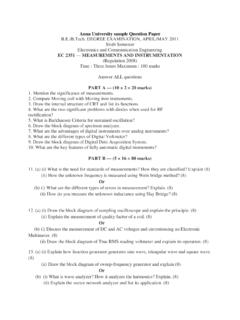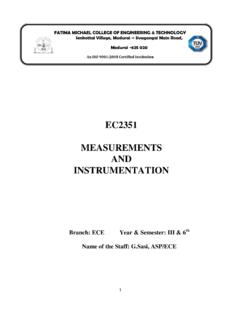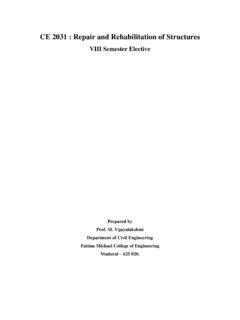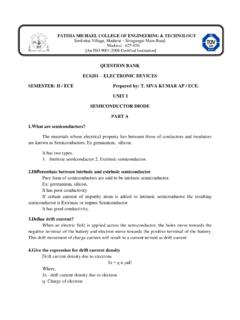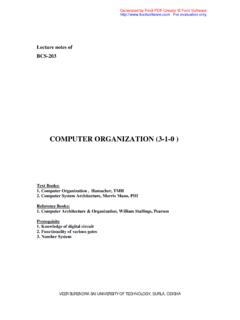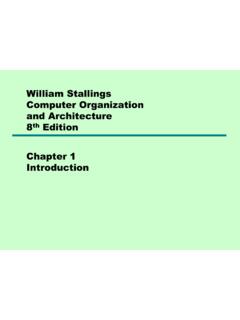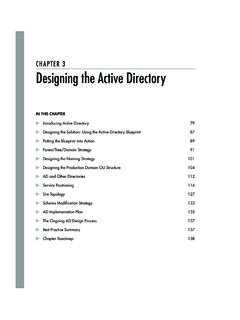Transcription of CS1252 – COMPUTER ORGANIZATION AND ARCHITECTURE
1 CS1252 COMPUTER ORGANIZATION AND ARCHITECTURE (Common to CSE and IT) L T P C 3 1 0 4 UNIT I BASIC STRUCTURE OF COMPUTERS 9 Functional units Basic operational concepts Bus structures Performance and metrics Instructions and instruction sequencing Hardware Software interface Instruction set ARCHITECTURE Addressing modes RISC CISC ALU design Fixed point and floating point operations. UNIT II BASIC PROCESSING UNIT 9 Fundamental concepts Execution of a complete instruction Multiple bus ORGANIZATION Hardwired control Micro programmed control Nano programming.
2 UNIT III PIPELINING 9 Basic concepts Data hazards Instruction hazards Influence on instruction sets Data path and control considerations Performance considerations Exception handling. UNIT IV MEMORY SYSTEM 9 Basic concepts Semiconductor RAM ROM Speed Size and cost Cache memories Improving cache performance Virtual memory Memory management requirements Associative memories Secondary storage devices. UNIT V I/O ORGANIZATION 9 Accessing I/O devices Programmed I/O Interrupts Direct memory access Buses Interface Circuits Standard I/O interfaces (PCI, SCSI, and USB) I/O Devices and processors.
3 L: 45 T: 15 Total: 60 TEXT BOOKS 1. Carl Hamacher, Zvonko Vranesic and Safwat Zaky, COMPUTER ORGANIZATION , 5th Edition, Tata Mc-Graw Hill, 2002. 2. Heuring, and Jordan, , COMPUTER Systems Design and ARCHITECTURE , 2nd Edition, Pearson Education, 2004. REFERENCES 1. Patterson, D. A., and Hennessy, , COMPUTER ORGANIZATION and Design:The Hardware/Software Interface , 3rd Edition, Elsevier, 2005. 2. William Stallings, COMPUTER ORGANIZATION and ARCHITECTURE designing for Performance , 6th Edition, Pearson Education, 2003.
4 3. Hayes, , COMPUTER ARCHITECTURE and ORGANIZATION , 3rd Edition, Tata Mc-Graw Hill, 1998. UNIT I BASIC STRUCTURE OF COMPUTERS Functional units Basic operational concepts Bus structures Performance and metrics Instructions and instruction sequencing Hardware Software interface Instruction set ARCHITECTURE Addressing modes RISC CISC ALU design Fixed point and floating point operations BASIC STRUCTURE OF COMPUTERS: COMPUTER ORGANIZATION : It refers to the operational units and their interconnections that realize the architectural specifications.
5 It describes the function of and design of the various units of digital COMPUTER that store and process information. COMPUTER hardware: Consists of electronic circuits, displays, magnetic and optical storage media, electromechanical equipment and communication facilities. COMPUTER ARCHITECTURE : It is concerned with the structure and behaviour of the COMPUTER . It includes the information formats, the instruction set and techniques for addressing memory. Functional Units A COMPUTER consists of 5 main parts. Input Memory Arithmetic and logic Output Control Units Functional units of a COMPUTER Input unit accepts coded information from human operators, from electromechanical devices such as keyboards, or from other computers over digital communication lines.
6 The information received is either stored in the computers memory for later reference or immediately used by the arithmetic and logic circuitry to perform the desired operations. The processing steps are determined by a program stored in the memory. Finally the results are sent back to the outside world through the output unit. All of these actions are coordinated by the control unit. The list of instructions that performs a task is called a program. Usually the program is stored in the memory. The processor then fetches the instruction that make up the program from the memory one after another and performs the desire operations.
7 Input Unit: Computers accept coded information through input units, which read the data. Whenever a key is pressed, the corresponding letter or digit is automatically translated into its corresponding binary code and transmitted over a cable to either the memory or the processor. Some input devices are Joysticks Trackballs Mouses Microphones (Capture audio input and it is sampled & it is converted into digital codes for storage and processing). Unit: It stores the programs and data. There are 2 types of storage classes Primary Secondary Primary Storage: It is a fast memory that operates at electronic speeds.
8 Programs must be stored in the memory while they are being executed. The memory contains large no of semiconductor storage cells. Each cell carries 1 bit of information. The Cells are processed in a group of fixed size called Words. To provide easy access to any word in a memory,a distinct address is associated with each word location. Addresses are numbers that identify successive locations. The number of bits in each word is called the word length. The word length ranges from 16 to 64 bits. There are 3 types of are RAM(Random Access Memory) Cache memory Main Memory RAM: Memory in which any location can be reached in short and fixed amount of time after specifying its address is called RAM.
9 Time required to access 1 word is called Memory Access Time. Cache Memory: The small,fast,RAM units are called Cache. They are tightly coupled with processor to achieve high performance. Main Memory: The largest and the slowest unit is called the main memory. ALU: Most COMPUTER operations are executed in ALU. Consider a example, Suppose 2 numbers located in memory are to be added. They are brought into the processor and the actual addition is carried out by the ALU. The sum may then be stored in the memory or retained in the processor for immediate use.
10 Access time to registers is faster than access time to the fastest cache unit in memory. Output Unit: Its function is to send the processed results to the outside world. Printers are capable of printing 10000 lines per minute but its speed is comparatively slower than the processor. Control Unit: The operations of Input unit, output unit, ALU are co-ordinate by the control unit. The control unit is the Nerve centre that sends control signals to other units and senses their states. Data transfers between the processor and the memory are also controlled by the control unit through timing signals.
